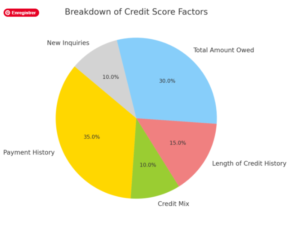Future-Proofing Your Finances: Innovative Technologies for Passive Income
In today’s world, the intersection of technology and finance offers new opportunities for securing your financial future. By leveraging these innovative solutions, you can create avenues for passive income that can help you achieve financial freedom. Let’s explore how you can future-proof your finances through various technological advancements.

Table of Contents
The Rise of Digital Investments
Digital investment platforms are transforming the way people manage their money.
They provide an accessible way to invest in stocks, bonds, and cryptocurrencies.
For instance, apps like Robinhood and E*TRADE allow you to trade with minimal fees, making it easier to grow your wealth without high barriers to entry.
Investing in ETFs (Exchange-Traded Funds) or index funds can provide diversified exposure to the market, making it simpler to manage risk while earning returns.
Real Estate Crowdfunding

Real estate has long been a stronghold for passive income, and technology has made it more accessible.
Platforms such as Fundrise and RealtyMogul let you invest in real estate projects without the need to buy a whole property.
These crowdfunding opportunities allow you to pool your money with other investors, opening doors to commercial and residential properties that can generate rental income or capital appreciation.
Automated Savings and Investment Tools
Many apps now offer automated savings features that round up your purchases and invest the spare change.
For example, Acorns and Qapital provide users with a seamless way to build their investments without much effort. By enabling features that automatically switch to savings or investment accounts, they help you future-proof your finances with minimal disruption to your daily routine.
Peer-to-Peer Lending
Peer-to-peer lending platforms like Prosper and LendingClub allow you to lend money directly to individuals or small businesses. In return, you earn interest over time just as a bank would.
This type of passive income can often deliver returns higher than traditional savings accounts or CDs.
The key is diversifying your loans to mitigate risks associated with borrower defaults.

Income through Content Creation
The internet has opened endless opportunities for content creators.
Platforms like YouTube, Patreon, and Medium allow you to share your expertise or passion and monetize your content.
Here’s how you can leverage this technology:
- Ad Revenue: Create videos or written content that attract viewers and generate ad revenue.
- Subscriptions: Build a subscriber base on platforms like Patreon for consistent income.
- Affiliate marketing: Promote products in your content and earn commissions on sales.
Smart Finance Apps
Digital wallets and finance management apps like Mint and Personal Capital can help you keep track of your expenses and investments in real time.
By automating budgeting and providing insights into your financial habits, these tools empower you to make informed decisions.
When you know where your money goes, you can better allocate resources to passive income opportunities.
Cryptocurrency Staking

As a burgeoning area of investment, cryptocurrency staking allows you to earn rewards by locking your digital assets in a blockchain network.
This process helps maintain the security of the network while generating passive income for you.
As cryptocurrencies gain traction, staking could become a viable option for diversifying your income streams.
Utilizing Robo-Advisors
Robo-advisors are increasingly popular for people looking to invest without managing their portfolios actively.
Services like Betterment and Wealthfront create a diversified investment strategy tailored to your needs and risk tolerance, often at a lesser fee than traditional financial advisors.
The AI-driven approach enables you to sit back while your money works for you.
Subscription-Based Businesses
Innovative entrepreneurs are turning to subscription models, where customers pay a regular fee for access to products or services.
Whether it’s software, lifestyle goods, or educational content, this model provides a steady stream of income.
If you’re considering starting a business, think about how technology can help you develop a subscription service that meets customers’ ongoing needs.
By recognizing and leveraging these technological opportunities, you can successfully future-proof your finances. Embrace innovation today to establish reliable passive income streams, ensuring a sound financial future for yourself and your loved ones.
Exploring Different Streams of Passive Income in the Digital Age
In today’s fast-paced world, many people are seeking ways to make money without having to trade their time for every dollar earned.
The digital age offers an array of opportunities for generating passive income, which allows you to earn money with minimal ongoing effort.
Here’s a look at various streams of passive income you can explore.
Online Courses and E-books
If you’re knowledgeable in a specific area, creating an online course or writing an e-book can be a great way to earn passive income.
Platforms like Udemy and Teachable enable you to host your courses, while Amazon Kindle Direct Publishing allows authors to sell e-books with ease.
Once your content is published, you can earn royalties with minimal work, allowing you to focus on other interests.
Affiliate Marketing
Affiliate marketing involves promoting products or services and earning a commission for every sale made through your referral link.
You can start by joining affiliate programs from companies like Amazon, ShareASale, or ClickBank. Creating quality content, such as blogs or videos that review or highlight these products, can help drive traffic to your affiliate links.
Investing in Dividend Stocks
Investing in dividend-paying stocks is another smart way to build passive income.
These are shares of companies that pay a portion of their earnings to shareholders regularly.
To get started, consider utilizing investment apps like Robinhood or Acorns.
With a well-diversified portfolio of dividend stocks, you can receive regular payments while also benefiting from potential capital appreciation.
Real Estate Crowdfunding
For those interested in real estate but who may not have the capital for outright purchases, real estate crowdfunding platforms, such as Fundrise and RealtyMogul, provide an alternative.
These platforms allow you to invest in real estate projects with smaller amounts of money.
You can earn passive income through rental yields or property appreciation, depending on the project.
Creating a Blog or YouTube Channel
Building a successful blog or YouTube channel can become a lucrative source of passive income over time. It requires hard work upfront, but once your content is established, you can earn money through advertising (such as Google AdSense), sponsored posts, and affiliate marketing.
Choose a niche you are passionate about, and engage with your audience to create a loyal following.
Print on Demand
If you have a knack for design, print-on-demand services can be an excellent passive income stream.
Websites like Redbubble and Teespring allow you to create custom designs for apparel, home decor, and more. Once you create the designs and list your products on these platforms, the service handles production, shipping, and customer service, letting you earn money without additional hassles.
Peer-to-Peer Lending
Platforms like LendingClub or Prosper facilitate peer-to-peer lending, where you can invest in personal loans for individuals or businesses. You earn interest on the repayment, creating a steady flow of passive income.
However, it’s essential to consider the risks involved, as not all borrowers may repay their loans.
Ground Your Strategy in Automation
To truly take advantage of passive income, consider how technology can help.
Tools like automated investment managers (robo-advisors), social media schedulers, and email marketing platforms streamline your efforts.
Leveraging technology can free up your time and keep your income streams running efficiently.
Starting with a Solid Plan
Before diving into any of these passive income streams, it’s vital to do your research and create a plan.
Evaluate your skills, resources, and interests to find what aligns best with your goals.
Diversifying across several streams can also help mitigate risk and lead to a more stable income over time.
Passive income takes patience and effort upfront, but once established, it can significantly enhance your financial security.
The digital age provides endless opportunities for those willing to invest time and effort into finding the right income streams.
With determination and the right strategies, you can secure a brighter financial future.
The Role of Automation in Managing Financial Investments
The world of finance is rapidly evolving, and automation is leading the way in improving the way we manage our investments.
Investors, both novice and expert, can now leverage technology to make better financial decisions with ease.
Let’s explore how automation enhances investment strategies.
Many investors find it challenging to keep track of their investments.
Automated platforms can help simplify this daunting task.
By using software to manage your portfolio, you take the guesswork out of investment decisions.
This allows you to focus on your overall financial wellness instead of micro-managing every financial input.
Benefits of Automation in Investing
Automation in investment management comes with numerous advantages:
- Time Efficiency: Automated systems can execute trades much faster than humans, ensuring you don’t miss out on potential opportunities.
- Reduced Emotional Decision-Making: Automation minimizes the impact of emotions on investment decisions, allowing for more rational and objective choices.
- Consistency: Algorithms can help you stick to your investment strategy without wavering due to market fluctuations.
- Accessibility: Automation tools and apps are available to anyone with an internet connection, making investing more accessible than ever.
- Data-Driven Insights: Automated systems can analyze vast amounts of data quickly, offering insights that help inform investment strategies.
For instance, robo-advisors are one of the most popular forms of automated investment management.
They typically assess your financial situation and risk tolerance before creating a personalized portfolio.
You simply answer a series of questions online, and the robo-advisor handles the rest.
This method is especially beneficial for first-time investors who may feel overwhelmed by traditional investing methods.
How Automation Enhances Portfolio Management
Implementing automation can transform how you manage your investment portfolio.
Here are several ways automation plays a crucial role:
Rebalancing: Automated platforms can regularly rebalance your portfolio to maintain a desired asset allocation.
This is important because market fluctuations can change your risk exposure over time.
Tax-Loss Harvesting: Advanced automated systems can identify losing investments to sell at a loss, offsetting taxes on gains elsewhere, which is an effective tax strategy.
Recurring Investments: You can set up automated contributions to your investment account, allowing you to invest regularly without thinking about it.
Beyond robo-advisors, technology like algorithms and artificial intelligence (AI) is stepping into investment management.
These tools analyze trends and market patterns, helping you make informed decisions based on historical data.
Automation Tools to Explore
If you’re considering integrating automation into your investment strategy, several tools can assist you:
- Betterment: A user-friendly platform that offers automated portfolio management tailored to your individual goals.
- Wealthfront: Provides financial planning features and tax optimization strategies through automation.
- M1 Finance: Combines the features of a robo-advisor with the necessary control to customize your portfolio.
- Acorns: Rounds up your purchases and invests the spare change automatically, making investing seamless.
When selecting an automation tool, consider your investment goals, risk tolerance, and budget. It’s essential to choose a platform that aligns with your financial objectives and provides a personalized experience.
In a world where time is money, automation offers a powerful solution for individuals seeking to optimize their financial investments.
By minimizing emotional decisions and enhancing efficiency, automation allows every investor to take control of their financial future.
Whether you are just starting or have been investing for years, utilizing automation can be a game-changer in building wealth and achieving financial independence.
Ultimately, embracing automation means you can leverage technology to navigate the complex world of investing with greater ease.
As you explore various methods and tools, remember that the goal is to make your financial journey simpler and more effective.
Essential Tools for Budgeting and Saving in a Tech-Driven World
In today’s fast-paced, tech-driven world, effective budgeting and saving can seem overwhelming.
However, the right tools can make these essential tasks much easier.
Here are some key tools and apps that help you manage your finances efficiently.
Budgeting Apps
Budgeting apps are one of the most crucial tools for anyone looking to take control of their finances.
These apps simplify budgeting by providing a user-friendly interface and innovative features.
- Mint: This popular app lets you link all your bank accounts, credit cards, and loans in one place. It categorizes your transactions and tracks your spending, helping you see where your money goes.
- You Need A Budget (YNAB): YNAB encourages you to take a proactive approach to your money. It focuses on giving every dollar a job and teaching you to save for future expenses rather than relying on your current income.
- EveryDollar: This tool is designed for zero-based budgeting. It allows you to create a budget in just minutes by listing your income and expenses.
Saving Apps
Saving apps can help you build your savings automatically. Here are a few that stand out:
- Qapital: With Qapital, you can set saving goals and rules. For example, you can set it to save a certain amount whenever you make a purchase. It’s a fun way to save without thinking too much about it.
- Acorns: This app rounds up your purchases to the nearest dollar and invests the spare change. It’s an effortless way to start investing while saving money for the future.
- Digit: Digit analyzes your spending patterns and automatically saves you small amounts of money. It’s an intelligent way to save without changing your lifestyle.
Expense Trackers
Tracking your expenses is critical for a successful budgeting plan. Here are tools that can help:
- Personal Capital: This platform offers free tools for budgeting and investment tracking. With a robust focus on retirement planning, it helps you see your entire financial picture in one dashboard.
- Wally: Wally allows you to scan your receipts and set a budget. It helps you understand your spending habits better by tracking where each dollar goes.
- Spendee: This app lets you categorize expenses and offers a shared wallet feature for couples or friends. It’s great for keeping track of joint expenses.
Automatic Savings Tools
Automating your savings is an excellent way to ensure you save consistently. Consider these tools:
- Chime: This online bank helps you save automatically with its “Save When You Get Paid” feature, where a percentage of your paycheck is automatically transferred to your savings account.
- Simple: Simple offers an innovative feature called “Goals” that helps you set money aside for specific savings goals. It automatically divides your funds, making savings straightforward.
- High-yield Savings Accounts: Online banks like Ally and Marcus offer higher interest rates than traditional banks. Setting up an automatic transfer could maximize your savings.
Financial Planning Tools
Beyond budgeting and saving, it’s important to plan for your financial future. Here are tools that can help:
- FutureAdvisor: This investment management service provides personalized advice based on your financial situation. It’s a useful tool for those looking to grow their wealth.
- Wealthfront: Wealthfront automates your investments and offers financial planning tools for short- and long-term goals.
- SmartAsset: An online resource that offers calculators for a variety of financial decisions including retirement and homebuying, helping you make informed financial choices.
So, whether you’re delving into budgeting, saving, or financial planning, leveraging technology can significantly enhance your financial life. These tools simplify complex processes and pave the way for a more secure financial future. By integrating these resources into your routine, you can take definitive steps towards mastering your money.
Building Your Financial Portfolio: Strategies for Long-Term Growth
Building a strong financial portfolio is essential for achieving long-term growth and security. Whether you are just starting out or looking to enhance your existing investments, understanding effective strategies can set you up for success.
Here are some key approaches to consider.
Understand Your Financial Goals
Before diving into investment choices, you need to identify your financial goals. Consider what you want to achieve in the short term and the long term. This can include:
- Saving for retirement
- Buying a home
- Funding your children’s education
- Building wealth for travel or leisure
Having clear objectives helps you choose the right investments that align with your aspirations.
Diversify Your Investments
Diversification is one of the fundamental principles of investing. By spreading your money across various asset classes, you can minimize risks associated with market volatility. Consider including:
- Stocks: These can offer excellent growth potential, but also come with risk.
- Bonds: Generally considered safer, they provide fixed income.
- Real Estate: Investing in properties can generate passive income while appreciating in value.
- Mutual Funds: These are a collection of stocks and bonds, offering instant diversification.
- Index Funds: These funds track a specific market index, often with lower management fees.
Having a mix of these assets can buffer your portfolio against losses.
Utilize Technology for Smarter Investing
Today’s technology makes it easier than ever to manage your investments. Here are some ways you can leverage technology:
- Robo-Advisors: Automated platforms can create and manage your investment portfolio based on your goals.
- Investment Apps: These make it simple to track your investments and market trends on-the-go.
- Financial Tools: Use budgeting tools to manage expenses and identify more funds for investing.
- Online Courses: Educate yourself about investing through various online platforms.
With these technologies at your fingertips, you can make informed decisions promptly.
Regularly Review and Adjust Your Portfolio
Your financial situation and market conditions can change. Therefore, reviewing your portfolio regularly is crucial. Here are some strategies to keep your investment plan on track:
- Set a Schedule: Review your investments quarterly or bi-annually.
- Rebalance Your Portfolio: Ensure that your asset allocation aligns with your risk tolerance and goals.
- Stay Informed: Keep up with market trends and news that could impact your investments.
Adjustments may be needed as time passes, so stay proactive.
Focus on Long-Term Investments
Patience is key when building a financial portfolio. Investments should not be viewed as a short-term game. Here’s why:
- Overcoming Market Fluctuations: The market can be unpredictable. Adopting a long-term mindset helps you ride out the ups and downs.
- Compounding Interest: The sooner you invest, the more your money has the potential to grow through compounded returns.
- Lower Investment Costs: Frequent trading can lead to high fees. A buy-and-hold strategy reduces costs.
By focusing on long-term gains, you set yourself up for more significant financial growth over time.
Seek Professional Guidance
Sometimes, navigating investments can be overwhelming. In such instances, professional help can provide valuable insight. Consider these options:
- Financial Advisors: They can offer personalized advice based on your financial situation and goals.
- Investment Clubs: Join like-minded individuals to share insights and strategies.
- Workshops and Seminars: Many organizations offer educational sessions on various investment topics.
Professional guidance can lead to smarter decisions and better financial outcomes.
Building your financial portfolio requires careful planning, smart strategies, and ongoing management. By understanding your goals, diversifying your investments, leveraging technology, regularly reviewing your portfolio, focusing on the long term, and seeking professional advice when needed, you can position yourself for sustainable financial growth.
Conclusion
The digital revolution has transformed how we can build wealth through technology-enabled passive income streams. By embracing automation tools for investments, budgeting apps, and multiple income sources, you can create a resilient financial future. Success comes from strategically combining these technological solutions while maintaining a long-term perspective.
The key is to start implementing these strategies now to build sustainable income sources that can adapt to changing market conditions and help secure your financial independence.





